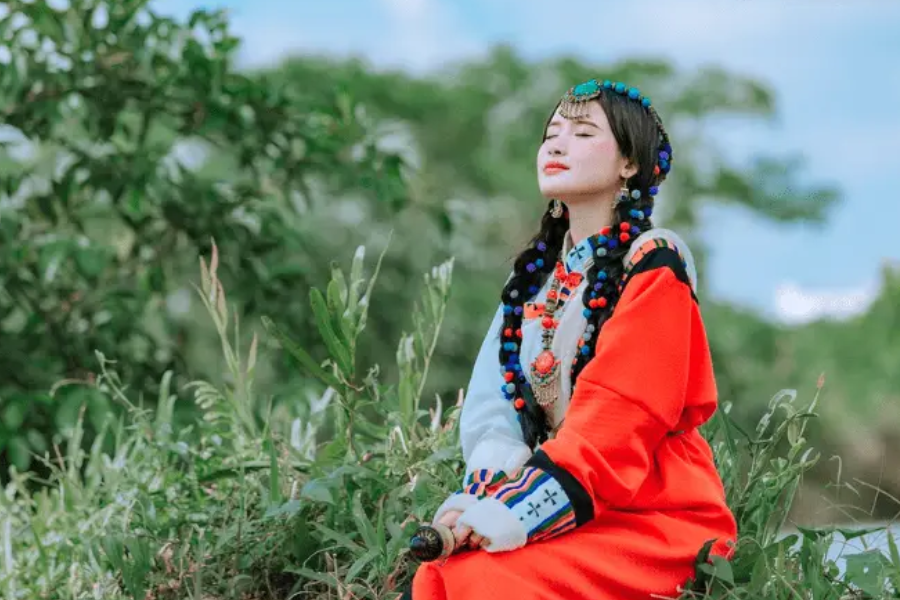The Amaziğ People: Guardians of North Africa’s Rich Heritage
Introduction
A Captivating Glimpse into Amaziğ Culture
In the heart of the Sahara Desert, a group of blue-robed men and women gather around a fire, their voices blending in a hauntingly beautiful song that has been passed down through generations. This is not just a cultural performance but a living testament to the resilience and vibrancy of the Amaziğ people, often known as the Berbers.
Thesis Statement
The Amaziğ people, often referred to as Berbers, are the indigenous inhabitants of North Africa with a rich tapestry of history, culture, and language.
Overview
The term “Amaziğ,” meaning “free people” or “noble men,” encapsulates the essence of a community that has maintained its identity through millennia of changing empires and cultures. Spread across Morocco, Algeria, Tunisia, Libya, and parts of Egypt, the Amaziğ are a testament to the enduring spirit of indigenous cultures.
Section 1: Who are the Amaziğ?
Origins and History
Pre-Roman North Africa
The history of the Amaziğ people stretches back to prehistoric times. Rock art in the Tassili n’Ajjer in Algeria and the Tadrart Acacus in Libya provides glimpses of early Amaziğ life, depicting scenes of daily activities and spiritual practices.
Roman Occupation and Influence
With the Roman conquest of North Africa in the 1st century BCE, the Amaziğ encountered new influences. While some Amaziğ tribes resisted Roman rule, others integrated, contributing significantly to the Roman military and adopting aspects of Roman culture.
Arab Conquest and Islamicization
The 7th century brought the Arab conquest and the spread of Islam, profoundly impacting Amaziğ society. While Islam became the predominant religion, many Amaziğ retained their language and distinct cultural practices, blending new influences with their ancient heritage.
Colonial Era and Amaziğ Identity
The colonial period, particularly under French and Spanish rule, saw renewed challenges to Amaziğ identity. Colonial powers often suppressed Amaziğ culture and language, leading to a resurgence of Amaziğ nationalism and efforts to preserve their heritage.
Amaziğ Resistance Movements
Throughout history, the Amaziğ have resisted foreign domination. From the legendary Queen Kahina who fought against Arab invaders to modern-day activists advocating for cultural and political rights, the Amaziğ resistance is a testament to their enduring spirit.
Geographical Distribution
Map of Amaziğ Regions in North Africa
Amaziğ communities are primarily found in Morocco, Algeria, Tunisia, Libya, and parts of Egypt. They are also present in the Sahel region, including Mali and Niger.
Major Amaziğ Communities
- Morocco: The largest Amaziğ population, with significant communities in the Rif and Atlas Mountains.
- Algeria: Concentrated in the Kabylie region, home to the Kabyle people, a prominent Amaziğ group.
- Tunisia: Smaller communities, particularly in the south and the island of Djerba.
- Libya: Notable groups include the Tuareg in the south and the Nafusa in the west.
- Egypt: The Siwa Oasis is home to a distinct Amaziğ community.
Demographics
Population Estimates
The Amaziğ population is estimated to be around 30-40 million, though precise numbers are difficult to determine due to varying definitions and government censuses.
Urban vs. Rural Amaziğ
Amaziğ people live in both urban and rural settings. While many have moved to cities for economic opportunities, rural areas remain strongholds of traditional Amaziğ culture.
Amaziğ Diaspora
The Amaziğ diaspora is significant, with communities in Europe (notably France, Spain, and Belgium), North America, and beyond, maintaining their cultural heritage abroad.
Section 2: The Amaziğ Language and Culture
Tamazight Language
Dialects and Variations
Tamazight, the language of the Amaziğ, includes several dialects such as Tarifit, Tashelhit, and Kabyle. Each dialect reflects the diversity and geographical spread of the Amaziğ people.
Revival Efforts and Language Education
In recent years, there has been a renewed effort to revive and standardize Tamazight. Countries like Morocco and Algeria have recognized Tamazight as an official language, promoting its use in education and media.
Importance of Tamazight in Amaziğ Identity
Tamazight is more than a means of communication; it is a core component of Amaziğ identity. Preserving the language is seen as essential to maintaining their cultural heritage.
Customs and Traditions
Amaziğ Social Structure and Family Life
Amaziğ society is traditionally organized around extended family units and clans. Social structures are often egalitarian, with a strong emphasis on community and mutual support.
Traditional Amaziğ Clothing and Jewelry
Amaziğ clothing, characterized by vibrant colors and intricate embroidery, reflects the artistry of the people. Jewelry, often made of silver and adorned with symbolic motifs, plays a significant role in Amaziğ culture.
Amaziğ Music, Dance, and Art
Amaziğ music and dance, such as the Ahidous and the Ahwash, are integral to their cultural expression. Visual arts, including pottery, weaving, and tattooing, are rich with symbolic meanings and traditional motifs.
Amaziğ Festivals and Celebrations
Festivals like Yennayer (Amaziğ New Year) and Imilchil Marriage Festival celebrate Amaziğ heritage. These events feature music, dance, and traditional foods, reinforcing community bonds.
Amaziğ Cuisine and Food Culture
Amaziğ cuisine, known for dishes like couscous, tagine, and flatbreads, is a blend of local ingredients and ancient recipes. Meals are often communal, reflecting the Amaziğ emphasis on family and hospitality.
Section 3: Amaziğ Identity and Challenges
Amaziğ Identity
The Concept of “Amaziɣiy”
“Amaziɣiy” embodies the pride and identity of the Amaziğ people. It signifies their connection to their land, language, and cultural heritage.
Amaziğ Nationalism and Self-Determination
Amaziğ nationalism seeks to preserve and promote Amaziğ culture, language, and political rights. Movements advocating for self-determination and cultural recognition have gained momentum in recent years.
Amaziğ Women and Gender Roles
Amaziğ women play a crucial role in preserving cultural traditions. While traditional gender roles persist, many Amaziğ women are leaders in education, activism, and the arts, challenging stereotypes and advocating for gender equality.
Challenges Faced by Amaziğ People
Marginalization and Discrimination
Despite their historical significance, Amaziğ people often face marginalization and discrimination. Their cultural and linguistic rights are frequently overlooked by national governments.
Land Rights and Resource Access
Land rights are a critical issue for many Amaziğ communities, particularly pastoralists and those in rural areas. Access to natural resources is often contested, leading to conflicts and displacement.
Environmental Threats to Amaziğ Communities
Environmental degradation and climate change pose significant threats to Amaziğ communities, particularly those reliant on traditional agricultural and pastoralist practices.
Amaziğ Activism and Movements
Notable Amaziğ Leaders and Activists
Figures like Fatima Tihihit and Hocine Ait Ahmed have been instrumental in advocating for Amaziğ rights and cultural preservation. Their work inspires new generations of activists.
Strategies for Preserving Amaziğ Culture and Language
Efforts to preserve Amaziğ culture include language revitalization programs, cultural festivals, and the promotion of Amaziğ arts and crafts. Education and media play pivotal roles in these strategies.
Amaziğ Representation in Politics and Government
Political representation is crucial for Amaziğ communities. In recent years, there has been progress in increasing Amaziğ voices in government and policy-making, although challenges remain.
Section 4: Amaziğ Heritage and Tourism
Historical Sites and Monuments
Ancient Amaziğ Ruins and Archaeological Discoveries
Sites like the ruins of Timgad in Algeria and the rock art of Tassili n’Ajjer provide insights into ancient Amaziğ civilizations. These sites are crucial for understanding the historical depth of Amaziğ culture.
UNESCO World Heritage Sites
Several Amaziğ cultural sites are recognized by UNESCO, including the Medina of Fez and the Ksar of Ait-Ben-Haddou in Morocco. These sites are important for cultural preservation and tourism.
Amaziğ Tourism
Popular Amaziğ Tourist Destinations
Tourist destinations like the Atlas Mountains, the Sahara Desert, and the coastal areas of North Africa offer opportunities to explore Amaziğ culture and landscapes.
Cultural Tourism and Heritage Preservation
Cultural tourism can play a vital role in preserving Amaziğ heritage. It promotes awareness and appreciation of Amaziğ culture while providing economic benefits to local communities.
Benefits of Amaziğ Tourism for Local Communities
Tourism can support local economies, create jobs, and fund cultural preservation projects. It also fosters cross-cultural understanding and respect for Amaziğ traditions.
Conclusion
Recap of Key Points
The Amaziğ people, as the indigenous inhabitants of North Africa, have a rich and diverse cultural heritage. Their history, language, and traditions reflect a unique identity that has persisted through centuries of change.
Future Outlook
The future of the Amaziğ people lies in their ability to balance modernity with tradition, preserving their language and culture while engaging with the broader world. Continued efforts in education, activism, and cultural promotion are essential.
Call to Action
Learning more about the Amaziğ and supporting their communities can help preserve this rich heritage
FAQs
1. Who are the Amaziğ people and where are they located?
The Amaziğ, also known as Berbers, are the indigenous people of North Africa. They primarily reside in Morocco, Algeria, Tunisia, Libya, and parts of Egypt. Additionally, Amaziğ communities can be found in the Sahel region, including Mali and Niger, as well as in the diaspora in Europe and North America.
2. What is the significance of the Tamazight language in Amaziğ culture?
Tamazight is a central element of Amaziğ identity. It encompasses various dialects such as Tarifit, Tashelhit, and Kabyle. The language’s revival and official recognition in countries like Morocco and Algeria are crucial for preserving Amaziğ cultural heritage. Tamazight not only facilitates communication but also embodies the history, traditions, and values of the Amaziğ people.
3. What are some traditional customs and festivals celebrated by the Amaziğ?
Amaziğ customs and traditions are rich and varied. Key aspects include:
- Social Structure: Extended families and clans with a strong sense of community.
- Clothing and Jewelry: Vibrant, embroidered garments and symbolic silver jewelry.
- Music and Dance: Traditional forms like Ahidous and Ahwash.
- Festivals: Celebrations such as Yennayer (Amaziğ New Year) and the Imilchil Marriage Festival.
- Cuisine: Dishes like couscous, tagine, and flatbreads that reflect their cultural heritage.
4. What challenges do the Amaziğ people face today?
The Amaziğ people face several challenges, including:
- Marginalization and Discrimination: Cultural and linguistic rights are often overlooked by national governments.
- Land Rights and Resource Access: Conflicts over land and natural resources.
- Environmental Threats: Climate change and environmental degradation affecting traditional agricultural and pastoralist practices. Efforts by Amaziğ activists and leaders aim to address these issues and promote cultural preservation.
5. How can tourists experience and support Amaziğ culture?
Tourists can explore Amaziğ culture through:
- Visiting Historical Sites: Ancient ruins and UNESCO World Heritage Sites such as the Medina of Fez and the Ksar of Ait-Ben-Haddou.
- Participating in Cultural Tourism: Engaging with local communities in the Atlas Mountains, the Sahara Desert, and coastal areas.
- Supporting Local Economies: Purchasing Amaziğ crafts, attending cultural festivals, and respecting local traditions. This not only enriches the travel experience but also supports the preservation of Amaziğ heritage and provides economic benefits to the communities.






